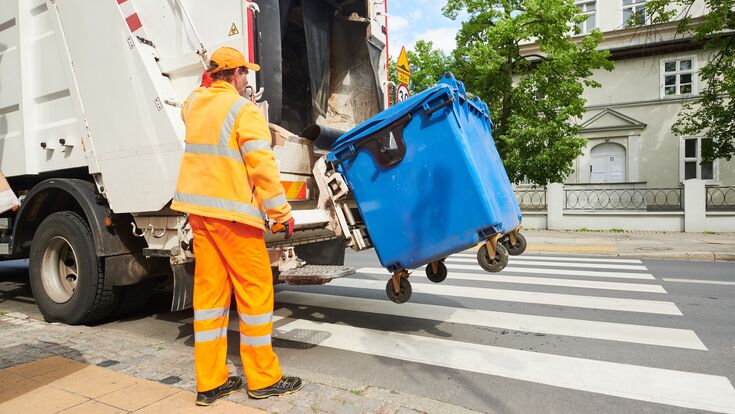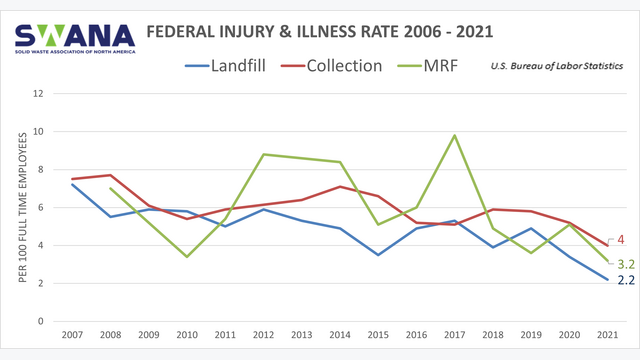Workplace saftey : Getting waste collection off the list of the most dangerous jobs

During the pandemic, workplace safety has become a buzzword. But when talking about it in the context of waste collection, we are not only considering face masks and disinfecting surfaces regularly. Or as David Biderman, Executive Director and CEO of the Solid Waste Association of North America (SWANA) put it: “Collecting waste is dangerous."
Solid waste collection workers are still on the list of the ten most dangerous jobs. From the truck itself to the collected garbage (lithium-ion batteries, syringes, glass, and chemicals: MSW has a lot of unexpected hazards in store), from distractions like mobile phones to bad weather conditions, from pedestrians to other drivers: The sources of danger are manifold. And more waste means more risks.
SWANA, therefore, has come up with a special safety programme including weekly Safety Matters tips for tailgate talks and training, Hauler Safety Outreach events at landfills and other sites, and events such as the Safety Summit occurring at WASTECON 2022 in San Diego, December 5 – 8. “We have good data for the US and that shows that one person who works in the industry is killed every week. And there are two fatal accidents per week in which collection services are involved. That is too much!” Biderman says (see figure 1 and 2)
But the problem is not US-specific. There are various reports of work-related deaths from countries such as India, Australia, Japan, Canada, Guyana, and Nigeria from this year alone. So it is time to focus on this problem and make waste collection safer and thus also more attractive for workers.
The basic safety tips are summarised under the motto “5 to stay alive”:
- Always wear PPE, especially high-visibility vests and/or outerwear
- Never use your cell phone while driving the truck or at a disposal facility
- Don’t ride on the step if the truck is BACKING or going more than 10mph or 1/5th mile
- Always comply with safety belt rules
- Don’t exceed the speed limit and don’t rush
Historic drop in injury and illness rates
Safety campaigns and awareness have an effect. The US Bureau of Labor Statistics (BLS) recently released its 2021 Survey of Occupational Injuries and Illnesses (SOII). It shows a continued decline in injury and illness rates with historic lows for solid waste landfill, collection, and material recovery facility (MRF) workers.
The injury and illness rate for solid waste landfill workers fell from 3.4 to 2.2 incidents per 100 full-time employees in 2021. The rate for solid waste collection went from 5.2 to 4, and the rate for workers at MRFs fell from 5.2 to 3.2. The injury and illness rates for all three sectors are at their lowest levels since at least 2006. (see figure 3). It should be noted, that the fatality data SWANA collects is usually broader than what BLS includes in its numbers, as Jesse Maxwell, Advocacy & Safety Senior Manager at SWANA explains: “There might be a difference in the number of workers fatalities reported by SWANA versus BLS but the trend lines are usually the same.”
The 2021 injury and illness survey is the second year in which COVID-19 workplace illnesses were reported in the US. The illness rate for solid waste collection fell from 22.4 per 100 full-time workers in 2020 down to 8.4 in 2021. Illness rate data was not made available for solid waste landfill or MRF employees.
Overall, private industry employers reported 2.6 million nonfatal workplace injuries and illnesses in 2021, a decrease of 1.8 percent from 2020. This decline was due to a drop in illness cases, with employers reporting 365,200 nonfatal illnesses in 2021, down from 544,600 in 2020, a drop of 32.9 percent. The rate of injury cases increased in 2021, with private industry employers reporting a rate of 2.3 cases per 100 FTE workers compared to 2.2 cases in 2020.
- © Source: U.S. Bureau of Labour StatisticsNevertheless, the industry itself is still the sixth deadliest occupation in the United States. “The new BLS data reflects a historic improvement in worker safety in the solid waste industry,” stated David Biderman. “Injury and illness rates last year were less than half of what they were in 2017. SWANA will continue leading industry efforts to reduce them even further and fulfill our Strategic Plan goal of getting solid waste collection workers off the list of the ten most dangerous jobs,” Biderman added.



